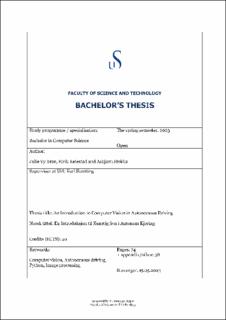| dc.description.abstract | Autonomous driving is one of the rising technology in today’s society. Thus, a wide range of
applications uses this technology for the benefits it yields. For instance, an autonomous driving
robot will free up the labor force and increase productivity in industries that require rapid
transportation. However, to gain these benefits, it requires the development of reliable and
accurate software and algorithms to be implemented in these autonomous driving systems. As
this field has been growing over the years, different companies have implemented this technology
with great success. Thus, the increased focus on autonomous driving technology makes this a
relevant topic to perform research on.
As developing an autonomous driving system is a demanding topic, this project focuses solely
on how computer vision can be used in autonomous driving systems. First and foremost, a
computer-vision based autonomous driving software is developed. The software is first imple-
mented on a small premade book-size vehicle. This system is then used to test the software’s
functionality. Autonomous driving functions that perform satisfactorily on the small test vehicle
are also tested on a larger vehicle to see if the software works for other systems. Furthermore, the
developed software is limited to some autonomous driving actions. This includes actions such
as stopping when a hindrance or a stop sign is detected, driving on a simple road, and parking.
Although these are only a few autonomous driving actions, they are fundamental operations
that can make the autonomous driving system already applicable to different use cases.
Different computer vision methods for object detection have been implemented for detecting
different types of objects such as hindrances and signs to determine the vehicle’s environment.
The software also includes the usage of a line detection method for detecting road and parking
lines that are used for centering and parking the vehicle. Moreover, a bird-view of the physical
world is created from the camera output to be used as an environment map to plan the most
optimal path in different scenarios. Finally, these implementations are combined to build the
driving logic of the vehicle, making it able to perform the driving actions mentioned in the
previous paragraph.
When utilizing the developed software for the driving task, hindrance detection, the result
showed that although the actual hindrances were detected, there were scenarios where block-
ades were detected even though there were none. On the other hand, the developed function
of stopping when a stop sign is detected was highly accurate and reliable as it performed as
expected. With regard to the remaining two implemented actions, centering and parking the
vehicle, the system struggled to achieve a promising result. Despite that, the physical validation
tests without the use of a vehicle model showed positive outcomes although with minor deviation
from the desired result. Overall, the software showed potential to be developed even further to
be applicable in more demanding scenarios, however, the current issues must be addressed first. | |
